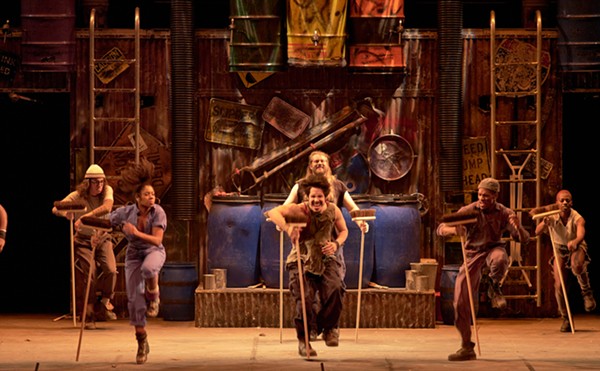Design for the Modern World: The Arts and Crafts Movement in Europe and America, 1880-1920 -- The art museum's first major arts-and-crafts show in years is notable not only for its enormous size, but for the many far-flung cultures (included are works from Germany, Scandinavia, Scotland, and Hungary) that share space. But what really unites these rooms of exquisitely designed teapots, tables, chairs, lamps, jewelry, and vases is the notion that arts and crafts are anything but stylistically homogeneous: Resisting the push toward industrialism, crafts practitioners cared about design that was beautiful but functional and, above all, honest in construction. Paramount was evidence of their origin -- visible screwheads on a chair or tiny hammer marks on a silver teapot; objects with such traits, even if they were mass-produced, were deemed inherently better. Some artists, like Henry Van de Velde, who designed an entire modernist dining room for a department store, also valued affordability. The movement was a lifestyle, too, with small communes forming around these principles. The exhibit culminates in America with some elegant chairs and lamps obviously designed by Frank Lloyd Wright. There's even a nod to Cleveland's golden age of enamel. In short, Design for the Modern World renders a potentially dull subject in the most compelling manner possible. Through January 8 at the Cleveland Museum of Art, 11150 East Blvd., 216-421-7340, www.clevelandart.org. -- Zachary Lewis
Dimensional Drift -- Unless outsider art is your thing, these crude paintings and sculptures by Clevelander John Arndt probably won't keep your interest; the artist's lack of formal training is evident to some degree in almost every piece. Foreshortening seems to be a concept of interest to Arndt, who experiments with it in a set of small relief portraits of dancers and joggers. They're not bad -- mostly just dull. His straight-up, two-dimensional paintings edge ahead of the rest because they, at least, have some vague, pulpy message to convey -- and some are even funny. Best is "The Blues Revolution in East Blankistan," a surreal scene in which a dark-bearded crowd agitates not for some political figure, but for B.B. King, as if music matters when poverty and chaos predominate. Finally, if one can get past the coloring-book quality of the picture, there is a bit of irony to savor in "Dovey 9/11 Cheesecake," a large painting of a buxom girl in a short skirt, posing with some doves in front of the Twin Towers. After all the gross political abuse of September 11, this tongue-in-cheek painting is almost therapeutic. Through December 31 at Doubting Thomas Gallery, 856 Jefferson Ave., 216-241-7800, www.geocities.com/doubtingthomas. -- Lewis
Drawn to Cleveland -- More than a tribute to a generous museum patron or to the city, this group exhibition feels like a reunion. Fourteen nationally recognized artists are represented here through various works on paper. Each is connected to Cleveland, and many have shown at MOCA previously, but beyond that common experience, they've followed widely different paths. Robert Crumb's anxiety-ridden cartoons are perhaps the most famous; the best of the five examples here is his most recent, a French-themed set about consumerism called "Creeping Global Villagism," from 2004. Dana Schutz is present through three captivating black-and-white portraits of friends, whom she conveys with brutal, vaguely cubist honesty; even her self-portrait, a figure with a jack-o'-lanternlike head, is unsparing. April Gornick and Heide Fasnacht, meanwhile, wield graphite and charcoal with stunning virtuosity. Gornick's "Allee" may be the most memorable piece in the show: Using charcoal, she captures the play of light moving between groves of neatly planted trees, the horizon receding almost infinitely. Fasnacht's "Big Bang," a picture of an explosion, is pencil-drawing at its most technically accomplished, but her "Sneeze V" is truly inspired: An icky mess spews across the immense page in the form of tiny, singed punctures to the paper. Through December 30 at the Museum of Contemporary Art Cleveland, 8501 Carnegie Ave., 216-421-8671, www.mocacleveland.org. -- Lewis
Growing Up -- More an environment than an exhibit, this cohesive little show by Cleveland Institute of Art student Brooke Inman immerses visitors in the past while inviting them to examine the present and future from that perspective. A 10-year-old might have created Inman's pictures of her childhood home -- and she wants us to imagine that one did, even though the black-and-white images are actually detailed prints made to resemble old photographs. This is also the case with a series of self-portraits, which depict Inman as resolutely cheerful, despite braces and bad hair, during some awkward, prepubescent phase. More affecting is Inman-as-a-child dreaming, on paper, of her future home, a perfect suburban dwelling complete with basketball court. She even pays tribute to fort-building, that quintessential childhood pastime, with a carpeted nook formed from an overturned sofa. Inside are two artist books with copies of the prints on the walls, turning the fort into a sort of study. The real coup de grace, though, is right in the front window: a walled-off section of the room that appears to be stuffed from floor to ceiling with old toys, a child's hidden stash. Adult artists reverting to childhood can grow tiresome quickly, but Inman's show is too small for that. It manages to prompt reflection on significant questions about what we decide to discard, gain, and hold onto as we age. Through January 21 at Raw & Co Gallery, 1009 Kenilworth Ave., 216-781-2211, www.rawandcogallery.com. -- Lewis
I Had Too Much to Dream Last Night -- Thank the Cleveland Institute of Art for this amply stocked show, for which students produced each piece during a recent studio class. Given the wide-ranging results, it's clear nobody found the theme confining. Kyle Moore's small ceramic beds, displayed on an antique bed frame, are particularly compelling in their portrayal of various nightmarish possibilities. There's the fear of vaporization in "Where We Once Were," in which a bed is burned, atom-bomblike, with only shadows of humans left behind; but just as disturbing is the fear of simple abandonment, shown in an empty bed called "White, Lonely Sleep State." Kate Kisicki's series of "Storm" paintings are surprisingly dissimilar; the best of them exude the majestic turbulence of a tidal-wave print by Hokusai. Justin Martin's set of envelopes labeled "good," "bad," and "ugly" are surreally amusing theatrical scenarios on paper, but it's his "It Wasn't All in My Head" that's among the show's most purely artistic entries: a pencil-drawn flow chart of his mental activity one evening in 2003. That night, Martin really did have too much to dream. Through January 14 at E. Gordon Gallery, 2026 Murray Hill Road, 216-795-0971, www.egordongallery.com. -- Lewis
Launching Zorcutt -- If Zachary Orcutt is anything like his eccentric alter ego Zorcutt, he's a guy you want at your party. In this off-the-wall show inspired by flight (both real and metaphorical, as in the artist transcending the mundane), Orcutt crafts large-scale flying machines that are more pleasing to the eye than functional; constructed of dense metals such as steel and bronze, they're far too fantastical to actually move, let alone become airborne. The focus is on Zorcutt's solo missions: "Ephemeral Flight" is a gigantic cross between a hang glider and a missile launcher, with two small foot platforms and handlebars, and barely enough room for the brave pilot it would require. In all his works, Orcutt spares no detail. The half-human, half-robot skeleton wearing the enormous jetpack in "Justin Case" rides an incredibly complex hunk of welded metal, with an engine supporting a propeller and an oxygen-fueled blast system. There's absurd humor in almost everything, but none more deadpan than "Home Security System," a big green bomb with directional fins. Jokes aside, there's a touching contradiction between these woefully earthbound objects and the innocently yearning spirit that conceived them. Orcutt is like the child who imagines his soapbox racer could beat a Ferrari. Through January 6 at the Sculpture Center, 1834 E. 123rd St., 216-229-6527, www.sculpturecenter.org. -- Lewis
Multiplicity -- Minimalism may not be a particularly deep aesthetic concept, but it has inspired some stunning visual work in this show, where patterns formed by otherwise mundane pieces yield large, viscerally moving creations in a variety of media. Sarah Chokyi Bauer's video of herself performing a repetitive Buddhist ceremony (flopping to the floor, standing up again) gets dull fast, but the two accompanying wall-size compilations of the individual film frames offer a beautiful experience enriched by subtle gradations in light from daytime to darkness. Each of Danielle Julian-Norton's pressed-rice boats, meanwhile, is a wonder unto itself, but dozens of them suspended from the ceiling (in "Treading and Transport") form something else altogether: a terrain that's weightless and fragile, but also faintly imposing. In the work of Patrick Gabler, small, inky-black curlicues painted in circles on huge paper scrolls become giant, feathery-textured planets with orbiting moons. Loren Schwerd's "Loveseat" consists of two wicker-bottomed chairs connected at their seats with long, woven strands of hair. It doesn't exactly fit the show's theme, but it's so creative, it hardly matters. Through January 6 at Spaces, 2220 Superior Viaduct, 216-621-2314, www.spacesgallery.org. -- Lewis
POPulence -- Splendor and extravagance are the defining traits of this large-scale group exhibition organized by the University of Houston Art Museum. From velvet DayGlo flowers on the floor to swooning visions in latex and acrylic on the walls, POPulence proves without question that pop art has moved into a brighter and more expansive new realm. It's tough to say who's furthest over the top, but L.C. Armstrong probably takes that honor. Her immense Hawaiian seascapes, complete with figures frolicking in the water, are almost ridiculously naive. Were it not for the frighteningly large flowers in the foreground, they might be perfect for travel brochures. Next in line is Chiho Aoshima, with her panoramic reveries about youthful aimlessness; her cute, anime-style figures drift like Japanese versions of Ophelia through scarily enchanted undersea environments fashioned out of film negatives and Plexiglas. Lacking any such narrative intent, David Reed takes graffiti art to a new level. He uses alkyd paints to create dynamic swirling lines so nearly three-dimensional, they're like liquids in motion. Kim Squaglia's colorful, multilayered combinations of latex, resin, and oil resemble Starburst chews and look good enough to eat. Then again, so do many pieces in this gloriously hedonistic exhibition. Glossy, sensuous, and full of references to contemporary culture, the whole show is candy for the eyes. Through December 30 at the Museum of Contemporary Art Cleveland, 8501 Carnegie Ave., 216-421-8671, www,mocacleveland.org. -- Lewis
Thomas Frontini -- Convivium 33, a new gallery housed in an overhauled Catholic church, is an enormous artwork unto itself, with its high arched ceilings, intricately carved woodwork, and raised altar. It's also huge, with wall space sufficient for major shows and gathering room enough for a small cavalry. Its inaugural exhibit features the equally distinctive paintings of Cleveland Heights artist Thomas Frontini. Complex, poignant, humorous, and wildly allusive, Frontini's work harks loudly back to the Renaissance, when cherubs, angels, and other mythical creatures were prime painterly subjects; but he also keeps one foot planted firmly in the 21st century -- Hummers and airplanes are everywhere. His flat, mural-like pieces center around human subjects, which are often dwarfed by timeless landscapes and the animals, both real and imaginary, that inhabit them. Frontini's imagination is breathtaking, his interests vast. Juxtaposing old artistic clichés with modern reality is his best trick, exemplified in "Bold Future," in which two centaurs play badminton near nuclear towers. Best of all, he has a sense of humor, and he doesn't spare himself: In "Birth of the Great Balladeer," a young man with a guitar (Frontini as a teenager?) stands proudly, like Botticelli's "Venus," on a clam shell, this one supported by mermaids. We should be glad he went into art instead. Through January 29 at Convivium 33, 1433 E. 33rd St., 216-881-7328, www.josaphatartshall.com. -- Lewis












